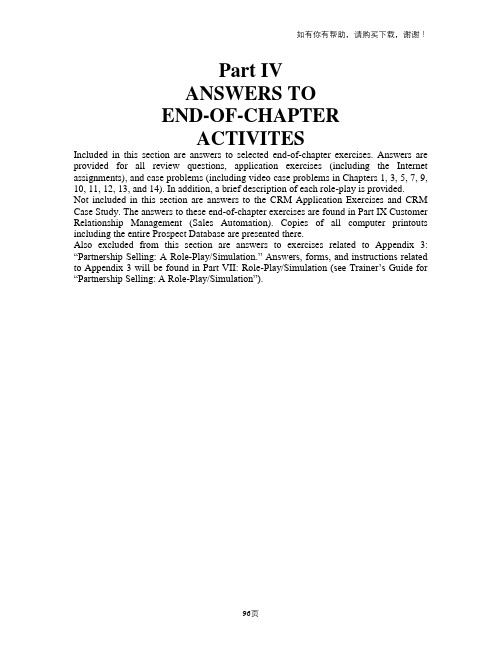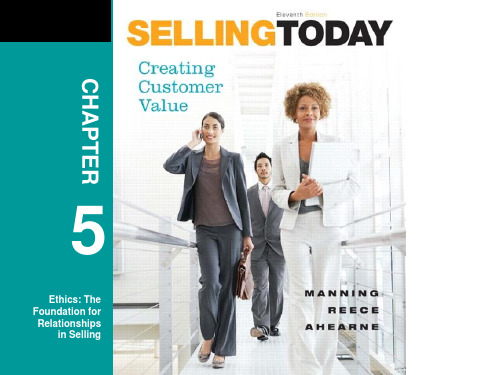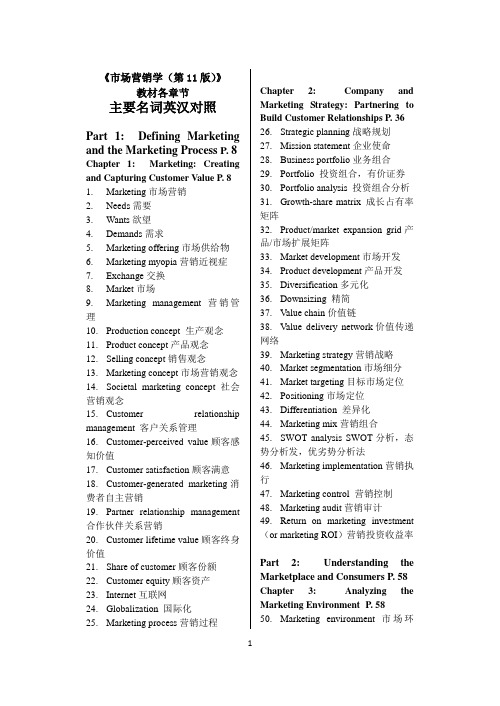现代销售学:创造顾客价值(第11版)Manning_11e_16
现代销售学创造顾客价值第11版

Part IVANSWERS TOEND-OF-CHAPTERACTIVITESIncluded in this section are answers to selected end-of-chapter exercises. Answers are provided for all review questions, application exercises (including the Internet assignments), and case problems (including video case problems in Chapters 1, 3, 5, 7, 9, 10, 11, 12, 13, and 14). In addition, a brief description of each role-play is provided.Not included in this section are answers to the CRM Application Exercises and CRM Case Study. The answers to these end-of-chapter exercises are found in Part IX Customer Relationship Management (Sales Automation). Copies of all computer printouts including the entire Prospect Database are presented there.Also excluded from this section are answers to exercises related to Appendix 3: “Partnership Selling: A Role-Play/Simulation.” Answers, forms, and instructions related to Appendix 3 will be found in Part VII: Role-Play/Simulation (see Trainer’s Guide for “Partnership Selling: A Role-Play/Simulation”).CHAPTER 1Answers to Review Questions1.In an era of limitless data, informed salespeople can help customers decide whichinformation has value and which information should be ignored. Customers who have less time to adjust to new products and circumstances value this assistance.2.The three prescriptive areas for the development of a successful personal sellingphilosophy are: (1) full acceptance of the marketing concept, (2) developing an appreciation for the expanding role of personal selling in our competitive national and international markets, and (3) assuming the role of a problem solver/partner.3.In adapting to the marketing concept, emphasis is now placed on satisfying thecustomer through “partnering.” Instead of “pushing” goods, salespeople now form relationships and seek to identify specific customer needs.4.Consultative selling emphasizes need identification that is achieved through effectivecommunication between the salesperson and customer. The salesperson assumes the role of consultant and offers well-considered recommendations. Negotiation replaces manipulation as the salesperson sets the stage for a long-term partnership.5.The four steps include: need discovery, selection of product, need-satisfactionpresentation, and servicing the sale.6.The four broad strategic areas that make up the selling process are: (1) developing arelationship strategy—success in selling depends heavily on the salesperson’s ability to develop, manage, and enhance interpersonal relations with the customer, (2) developing a product strategy—products and services represent problem-solving tools,(3) developing a customer strategy—sales and marketing efforts are organized aroundthe needs and desires of the customer, and (4) developing a presentation strategy—although the sales call may last no more than 25 minutes, the presentation is definitely a critical part of the selling process.7.In the 1990s, many companies began to see the merits of maintaining long-termrelationships. With more look-alike products, customers are seeking quality products and quality relationships.8.Value-added selling can be defined as a series of creative improvements in the salesprocess that enhance the customer experience. Salespeople can add value by carefully identifying the customer’s needs and then prescribing the best p ossible product solution. Value-added selling has surfaced in response to increased levels of competition and the growing complexity of many products and services. The value added by salespeople today is increasingly derived from intangibles such as the quality of the advice offered.9.The goal of strategic selling alliances is to achieve a marketplace advantage byteaming up with another company whose products or services fit well with your own.Both companies hope to achieve a mutual competitive advantage.10.Because salespeople are a vital link between a company and its customers, buyerswill usually form impressions about the company based on the salesperson. Suggestions/Answers for Application Exercises1.The outline should include the following topics: Economic benefits—development ofglobal markets; stimulate our local economy, which reduces unemployment.Consumer benefits—assistance with the purchase of complex products; service after the sale.2.She will have to: (1) research the kind of customer her product appeals to as well asthe customer’s motivation for purchasing the product; (2) improve the product by engineering product features that will appeal to the customer; (3) package and brand it so it will be convenient and memorable to the customer; (4) price the product so it will be within the economic means of the customer and yet allow the company to make a reasonable profit; (5) select dealers and physically transport and store the product so it will be available in the right place at the right time; and (6) promote the sale of the product by communicating to the consumer through the mediums of personal selling, advertising, and other forms of sales promotion.3.In teaching and selling, Sharon must be able to present scientific ideas accurately andpersuasively. She must be able to motivate others as well as enjoy working with people. The differences consist of working without a prearranged schedule; she will need to organize her own time in sales work. Compensation plans, especially extra financial incentive, are usually found in selling; they are not usually found in teaching.4.Students will find information regarding sales training offered by the company. Havethem print and submit this information. Likely similarities that students will mention are partnering, win-win exchanges, problem solving, understanding the customer’s business, value-added selling, adaptive selling, and others.Role-Play ExerciseProvide students with a brief introduction to the wide variety of pens and pencils available. A nice gold pen, for example, might sell for $100 or more.Solution for the Case Problem1.Yes, it appears that Smith has adopted the three prescriptions of a personal sellingphilosophy. He demonstrates adoption of the marketing concept because he is constantly seeking to offer his customers the best value. He appears to value personal selling because he participates in a high degree of ongoing training. He also approaches selling as a problem solver because he bundles insurance policies that are in the customer’s best interest and works with all individuals who directly or indirectly influence the sale.2.Smith has adopted the win-win philosophy; projects a professional image; andmaintains high ethical standards.3.Smith can create value for his customers by helping them understand complicatedinsurance terms, comparing terms across policies (and even competitors), bundling policies to save the customer money, providing information about new policy types, and quantifying the benefit of having a particular insurance policy or the risk of not having a particular insurance policy.4.Answers will vary depending on such things as the student’s prior work experience,career plans, etc.。
现代销售学:创造顾客价值(第11版)Manning_11e_13

FIGURE 13.1
Copyright © 2010 Pearson Education, Inc. Publishing as Prentice Hall
13-4
Negotiation Defined
• Working to reach an agreement that is mutually satisfactory to both buyer and seller
3. Demonstration (Chapter 12)
✓4. Negotiation
5. Close
6.Hale Waihona Puke Servicing the Sale
Copyright © 2010 Pearson Education, Inc. Publishing as Prentice Hall
13-3
Six-Step Presentation Plan
1. Understand the problem
2. Create alternative solutions that can add value
3. Periodically review acknowledged points of agreement
4. Do not make concessions too quickly
13-9
The Negotiations Worksheet
FIGURE 13.3
Copyright © 2010 Pearson Education, Inc. Publishing as Prentice Hall
13-
10
Conducting the Negotiation Session
现代销售学:创造顾客价值(第11版)Manning_11e_05

• Character is based on your internal values and the resulting judgments
• Ethical decisions you make reflect your character strength
5-14
Additional Policy Areas
• Sharing confidential information • Reciprocity • Bribery • Gift giving • Entertainment • Business defamation • Use of the Internet
5-3
Making Ethical Decisions
• Business ethics: principles and standards that guide behavior in the world of business
• They help translate your values into appropriate and effective behaviors
• Ethical standards filter down from the top • Organization’s moral tone, set by
management, is most important determinant of employee ethics • Managers must infuse ethical values in subordinates
and be prepared to deal with the consequences
《市场营销原理(第_11_版)》科特勒_课后习题答案

第1章营销:管理有价值的顾客关系1. “顾客价值和满意”是了解市场和消费者需求的五大核心概念之一,其他四项核心概念是什么?这五个概念中有没有一个概念比其他概念更重要?说出支持你答案的理由。
答:(1 )其他四个核心概念是:①需要、欲望和需求:②营销供给物(产品、服务和体验):③交换和关系:④市场。
它们与“顾客价值和满意”共同构成了了解市场和消费者需求的五大核心概念,其具体定义如下:需要(need )是指人们感到缺乏的一种状态,包括:对食物、衣服、保暖和安全的基本物质需要:对归属感和情感的社会需要:对知识和自我实现的个人需要:等等。
这些需要不是营销员创造的,而是人类所固有的。
欲望(want )是由需要派生出来的一种形式,它受社会文化和人们个性的限制。
当考虑到支付能力的时候,欲望就转换为需求(demand )。
营销供给物(marketing offer)是提供给某个市场未满足某种需要和欲望的产品、服务、信息和体验的组合。
交换(exchange )是指从他人那里取得想要的物品,同时以某种物品作为回报的行为。
市场(market )指某种产品的实际购买者和潜在购买者的集合。
这些购买者都具有某种欲望或需要,并且能够通过交换得到满足。
( 2 )这五个概念,并没有哪个明显的比另外的概念更重要,但如果非要选择一个最为重要的概念出来,那么可以认为“市场”这一概念是重中之重。
因为市场是所有营销任务的最基本的关注点和目标。
而营销的核心就是基于这样的一个理念:存在一个市场,它是某种产品的实际购买者和潜在购买者的集合,这些购买者都具有某种欲望或需要,并且能够通过交换得到满足。
2. 比较下列两种营销管理理念:“推销观念”和“营销观念”。
你能举出一个仍然把“推销观念”作为营销管理理念的市场或市场类型吗?答:( 1 )推销观念(selling concept )的基本假设是:如果组织不进行大规模的促销和推销,顾客就不会购买足够多的产品。
《市场营销学(第11版)》教材各章节主要名词英汉对照

《市场营销学(第11版)》教材各章节主要名词英汉对照Part 1: Defining Marketingand the Marketing Process P. 8 Chapter 1: Marketing: Creating and Capturing Customer Value P. 81.Marketing市场营销2.Needs需要3.Wants欲望4.Demands需求5.Marketing offering市场供给物6.Marketing myopia营销近视症7.Exchange交换8.Market市场9.Marketing management 营销管理10.Production concept 生产观念11.Product concept产品观念12.Selling concept销售观念13.Marketing concept市场营销观念14.Societal marketing concept社会营销观念15.Customer relationship management 客户关系管理16.Customer-perceived value顾客感知价值17.Customer satisfaction顾客满意18.Customer-generated marketing消费者自主营销19.Partner relationship management 合作伙伴关系营销20.Customer lifetime value顾客终身价值21.Share of customer顾客份额22.Customer equity顾客资产23.Internet互联网24.Globalization 国际化25.Marketing process营销过程Chapter 2: Company and Marketing Strategy: Partnering to Build Customer Relationships P. 3626.Strategic planning战略规划27.Mission statement企业使命28.Business portfolio业务组合29.Portfolio 投资组合,有价证券30.Portfolio analysis 投资组合分析31.Growth-share matrix 成长占有率矩阵32.Product/market expansion grid产品/市场扩展矩阵33.Market development市场开发34.Product development产品开发35.Diversification多元化36.Downsizing 精简37.Value chain价值链38.Value delivery network价值传递网络39.Marketing strategy营销战略40.Market segmentation市场细分41.Market targeting目标市场定位42.Positioning市场定位43.Differentiation 差异化44.Marketing mix营销组合45.SWOT analysis SWOT分析,态势分析发,优劣势分析法46.Marketing implementation营销执行47.Marketing control 营销控制48.Marketing audit营销审计49.Return on marketing investment (or marketing ROI)营销投资收益率Part 2: Understanding the Marketplace and Consumers P. 58 Chapter 3: Analyzing the Marketing Environment P. 5850.Marketing environment 市场环境51.Microenvironment微观环境52.Macroenviroment宏观环境53.Marketing intermediaries营销中间商54.Public公众55.Demography 人口统计56.Baby boomers婴儿潮世代57.Generation X X世代lennials(or Generation Y)千禧世代(Y世代)59.Economic environment经济环境60.Engel’s laws恩格尔法则61.Natural environment自然环境62.Technological environment技术环境63.Political environment政治环境64.Cultural environment文化环境Chapter 4: Managing Marketing Information to Gain Customer Insights P. 8265.Customer insights顾客洞察力66.Marketing information system (MIS)市场信息系统67.Internal database内部数据库68.Marketing intelligence营销情报69.Exploratory research探索性调研70.Descriptive research描述性调研71.Causal research因果性调研72.Secondary data二手数据mercial online database商业在线数据库74.Observational research观察式调研75.Ethnographic research民族志调研76.Survey research询问式调研77.Experimental research实验室调研78.Focus group interviewing 焦点小组访谈79.Online marketing research 在线营销调研80.Online focus group在线焦点小组81.Sample样本82.Customer relationship management (CRM)客户关系管理83.Questionnaire 调查问卷Chapter 5: Understanding Consumer and Business Buyer Behavior P. 10884.Culture文化85.Subculture亚文化86.Social class 社会阶层87.Group 团队88.Opinion leader 意见团队89.Online social networks 在线文化网络90.Lifestyle 生活方式91.Personality 个性92.Motive(Drive)动机(驱动力)93.Perception感知94.Learning学习95.Belief信念96.Attitude态度97.Cognitive dissonance 认知失调98.New product 新产品99.Adoption process 采用过程100.Business buyer behavior 产业购买者行为101.Derived demand 派生需求102.Straight rebuy 直接重购103.Modified rebuy 修订重购买104.New task 新任务105.Systems selling(or solutions selling)系统销售(解决方案营销)106.Buying center 采购中心107.Value analysis 价值分析Part 3: Designing a Customer-DrivenMarketing Strategy and Mix P. 138 Chapter 6: Customer-Driven Marketing Strategy: Creating Value for Target Customers P. 138108.Market segmentation 市场细分109.Market targeting(targeting)目标市场选择110.Differentiation 差异化111.Positioning 市场定位112.Geographic segmentation 地理细分113.Demographic segmentation 人口细分114.Age and life-cycle segmentation 年龄和生命周期细分115.Gender segmentation 性别细分116.Income segmentation 收入细分117.Psychographic segmentation 心里细分118.Behavior segmentation 行为细分119.Occasion segmentation 时机细分120.Benefit segmentation 利益细分121.Customer loyalty 顾客忠诚度122.Intermarket segmentation 跨国市场细分123.Target market 目标市场124.Undifferentiated (mass)marketing 无差异营销(大众营销)125.Differentiated (segmented)marketing 差异化营销(细分营销)126.Concentrated ()marketing 集中营销(利基营销)127.Micromarketing 微观营销128.Local marketing 地区营销129.Individual marketing 个性化营销130.Production position 产品定位petitive advantage 竞争优势132.Value proposition 价值主张133.Positioning statement 定位陈述Chapter 7: Products, Services, and Brands: Building Customer Value P. 164134.Product 产品135.Service 服务136.Customer product 消费品137.Convenience product 便利品138.Shopping product 选购品139.Specialty product 特殊品140.Unsought product 非渴求品141.Industrial product 产业用品142.Social marketing 社会营销143.Product quality 产品质量144.Brand 品牌145.Packaging 包装146.Product line 产品线147.Product mix (or product portfolio)产品组合148.Brand equity 品牌资产149.Store brand (or private brand)中间商品牌(自有品牌)150.Co-branding 合作品牌151.Line extension 产品延伸线152.Brand extension 品牌延伸153.Service intangibility服务的无形性154.Service inseparability服务的不可分离性155.Service variability服务的易变性156.Service perishability服务的易逝性157.Service-profit chain服务利润链158.Internal marketing 内部营销159.Interactive marketing 互动营销Chapter 8: Developing New-Product and Managing the Life-Cycle P. 192 160.New-product development 新产品开发战略161.Idea generation 产生创意162.Idea screening 筛选创意163.Product concept 产品观念164.Concept testing 概念测试165.Marketing strategy development 营销战略开发166.Business analysis 商业分析167.Product development 产品开发168.Test marketing 试销mercialization 商业化170.Customer-centered new-product development 以顾客为中心的新产品开发171.Team-based new-product development 基于团队的新产品开发172.Product life cycle 产品生命周期173.Style 风格174.Fashion 时尚175.Fad 热潮176.Introduction stage 导入期177.Growth stage 成长期178.Maturity stage 成熟期179.Decline stage 衰退期Chapter 9: Pricing:Understanding and Capturing Customer Value P. 212 180.Price价格181.Value-based pricing 价值导向定价182.Good-value pricing 最优价值定价183.Value-added pricing 价值增值定价184.Cost-based pricing 成本导向定价185.Fixed costs 固定成本186.Valuable costs 变动成本187.Total costs 总成本188.Cost-plus pricing 成本加成定价189.Break-even pricing (target profit pricing)盈亏平衡定价(目标利润定价)190.Target costing 目标成本法191.Demand curve 需求曲线192.Price elasticity 价格弹性193.Market-skimming pricing 市场撇脂定价194.High-definition television (HDTV)高清电视195.Market-penetration pricing 市场渗透定价196.Optional-product pricing 附属产品定价197.By-product pricing 副产品定价198.Product bundle pricing 产品捆绑定价199.Discount 折扣200.Allowance 折让201.Segmentation pricing 细分定价202.Psychological pricing 心理定价203.Reference pricing 参考定价204.Promotional pricing 促销定价205.Geographical pricing 地理定价206.Dynamic pricing 动态定价Chapter 10: Marketing Channels: Delivering Customer Value P. 242 207.Value delivery network 价值传递网络208.Marketing channel (distribution channel)营销渠道(分销渠道)209.Channel level 渠道层级210.Direct marketing channel 直接营销渠道211.Channel conflict 渠道冲突212.Conventional distribution channel 传统分销渠道213.Vertical marketing system (VMS)垂直营销系统214.Corporate VMS公司VMS(垂直营销系统)215.Contractual VMS 合同式VMS (垂直营销系统)216.Franchise organization 特许经营组织217.Administered VMS 管理式VMS (垂直营销系统)218.Horizontal marketing system 水平营销系统219.Multichannel distribution system 多渠道分销系统220.Disintermediation 去中介化221.Marketing channel design 营销渠道设计222.Intensive distribution 密集分销223.Exclusive distribution 独家分销224.Selective distribution 选择性分销225.Marketing channel management 营销渠道管理226.Marketing logistics (physical distribution)营销物流(物流)227.Supply chain management 供应链管理228.Distribution center 分销中心229.Intermodal transportation 多式联运230.Integrated logistics management 整合物流管理231.Third-party logistics (3PL)provider 第三方物流供应商Chapter 11: Retailing and Wholesaling P. 262232.Retailing 零售233.Specialty store 专卖店234.Department store 百货商店235.Supermarket 超级市场236.Convenience store 便利店237.Superstore 超级商店238.Category killer 品类杀手239.Service retailer 服务零售店240.Discount store 折扣商店241.Off-price retailer 廉价零售店242.Independent off-price retailer 独立廉价零售商243.Factory outlet 工厂直营店244.Warehouse club 仓储俱乐部245.Chain store 连锁店246.Franchise 特许经营247.Shopping center 购物中心248.Wheel-of-retailing concept 零售轮转理论249.Wholesaling 批发250.Wholesaler 批发商251.Merchant wholesaler252.Broker253.Agent254.Manufacturer’s sales branches and offices 制造商的销售分发机构和办事处Chapter 12: Communicating Customer Value: Advertising and Public Relations P. 294255.Promotion mix (Marketing Communication Mix)营销组合(营销沟通组合)256.Advertising 广告257.Sales promotion 销售促进258.Personal selling 人员推销259.Public relations 公告关系260.Direct marketing 直复营销261.Integrated marketing communication (IMC)整合营销沟通262.Push strategy 推式战略263.Pull strategy 拉式战略264.Advertising objective 广告目标265.Advertising budget 广告预算266.Affordable method 量力而行法267.Percentage-of-sale method 销售百分比法petitive-parity method 竞争对等法269.Objective-and-task method 目标任务法270.Advertising strategy 广告战略271.Madison & Vine 麦迪逊大街和好莱坞藤街272.Creative concept 创意概念273.Execution style 创作文体274.Advertising media 广告媒体275.Return on advertising investment 广告投资收益率276.Advertising agency 广告代理商277.Public relation 公共关系Chapter 13: Personal Selling and Sales Promotion P. 324278.Personal selling 人员推销279.Salesperson 销售人员280.Sale force management 销售队伍管理281.Territorial sales force structure 地域型销售组织机构282.Product sales force structure 产品型销售组织机构283.Customer sales force structure 顾客型销售组织机构284.Outside sales force (or field sales force)外部销售队伍(现场销售队伍)285.Inside sales force 内部销售队伍286.Team selling 团队销售287.Sales quota 销售定额288.Selling process 销售过程289.Prospection 寻找线索290.Preapproach 事先调查291.Approach 接触访问292.Presentation 展示293.Handling objection 排除异议294.Closing 完成交易295.Follow-up 后续工作296.Sales promotion 销售促进297.Customer promotions 消费者销售促进298.Event marketing 事件营销299.Trade promotion 贸易销售促进300.Business promotions 商业销售促进Chapter 14: Direct and Online Marketing: Building Direct Customer Relationships P. 348301.Direct marketing 直复营销302.Customer database 顾客数据库303.Direct-mail marketing 直接邮寄营销304.Catalog marketing 目录营销305.Telephone marketing 电话营销306.Direct-response television marketing 电视直销307.Online marketing 在线营销308.Internet 互联网309.Click-only companies 点击企业(即在线交易公司)310.Click-and-mortar companies 虚实结合营销311.Business-to-customer (B2C)online marketing 企业对消费者的在线营销312.Business-to-business (B2B)online marketing企业对企业的在线营销313.Customer-to-customer (C2C)online marketing消费者对消费者的在线营销314.Customer-to-business (C2B)online marketing消费者对企业的在线营销315.Corporate (or brand)Web site 公司(品牌)网站316.Marketing Web site 营销网站317.Online advertising 在线广告318.Viral marketing 病毒营销319.Online social networks 在线社交啊网络320.Spam 垃圾邮件Part 4: Extending Marketing P. 372Chapter 15: The Global Marketplace P. 372321.Global marketplace 全球市场322.Global firm 跨国公司323.Economic community 经济共同体324.Americanization 美国化325.Exporting 出口326.Joint venturing 组建合资公司327.Licensing 许可经营328.Contract manufacturing 合同制造329.Management contracting 合同管理330.Joint ownership 合同所有331.Direct investment 直接投资332.Standardized global marketing 全球标准化营销333.Straight product extension 直接产品延伸334.Product adaptation 产品适应335.Product invention 产品创新munication adaptation 沟通适应337.Whole-channel view 整渠道视野Chapter 16: Sustainable Marketing: Social Responsibility and Ethics P. 394 338.Consumerism 消费者保护主义339.Environmentalism 环境保护主义340.Environmental sustainability 环境可持续发展341.Enlightened marketing 远见营销342.Consumer-oriented marketing 消费者导向营销343.Customer-value marketing 顾客价值营销344.Innovative marketing 创新营销345.Sense-o-mission marketing 使命感营销346.Societal marketing 社会营销347.Deficient product是不完善的产品348.Pleasing products 令人愉快的产品349.Salutary products 有益的产品。
现代销售学:创造顾客价值(第11版)Manning_11e(3)

Nonverbal clues
• Facial expression changes
• Prospect nods agreement
• Leans toward you
• Examines product literature intently
Copyright © 2010 Pearson Education, Inc. Publishing as Prentice Hall
respect first • After asking,
remain quiet
Copyright © 2010 Pearson Education, Inc. Publishing as Prentice Hall
14-18
Summary-of-Benefits Close
• Reemphasize value-added buyer benefits
3. Demonstration (Chapter 12)
4. Negotiation (Chapter 13)
5. Close
6. Servicing the Sale
Copyright © 2010 Pearson Education, Inc. Publishing as Prentice Hall
See the Website
Copyright © 2010 Pearson Education, Inc. Publishing as Prentice Hall
14-7
Strategic Planning
FIGURE 14.2
Copyright © 2010 Pearson Education, Inc. Publishing as Prentice Hall
- 1、下载文档前请自行甄别文档内容的完整性,平台不提供额外的编辑、内容补充、找答案等附加服务。
- 2、"仅部分预览"的文档,不可在线预览部分如存在完整性等问题,可反馈申请退款(可完整预览的文档不适用该条件!)。
- 3、如文档侵犯您的权益,请联系客服反馈,我们会尽快为您处理(人工客服工作时间:9:00-18:30)。
• Discuss stress management practices
Copyright © 2010 Pearson Education, Inc. Publishing as Prentice Hall
• Develop personal goals • Prepare daily “to do” lists • Maintain planning calendar • Organize selling tools
Copyright © 2010 Pearson Education, Inc. Publishing as Prentice Hall
contact • Cell phones/pagers as timesaving tools • Electronic file transfers
Heather Gardner uses her Blackberry and Microsoft
Outlook calendar to record all of her planned activities.
Copyright © 2010 Pearson Education, Inc. Publishing as Prentice Hall
16-8
The To-Do List
A daily list of activities can help set priorities and save time. Today this list is recorded electronically in most CRM systems like . See the website ing activities
• On average, 60 percent of time spent on administrative duties and travel
• Log keeping shows where time is spent, identifies “time wasters”
• Time management
• Sound time management can lead to increased sales
Copyright © 2010 Pearson Education, Inc. Publishing as Prentice Hall
16-6
Time Management Methods
• Time management • Territory management • Records management • Stress management
Copyright © 2010 Pearson Education, Inc. Publishing as Prentice Hall
16-5
16-3
Increasing Sales Volume
• The successful salesperson depends on:
• Good self-management • Good record keeping • Use of self-discipline in scheduling time and
• Explain factors that contribute to improved territory management
Copyright © 2010 Pearson Education, Inc. Publishing as Prentice Hall
16-2
Learning Objectives
CHAPTER
16
Opportunity Management: The
Key to Greater Sales
Productivity
Learning Objectives
• Discuss the four dimensions of opportunity management
• List and describe time-management strategies
Copyright © 2010 Pearson Education, Inc. Publishing as Prentice Hall
16-10
Monthly Planning Calendar
A monthly plan of activities can also set priorities and save time. Like other types of planning lists, it is recorded in CRM systems like . See the website at
analysis of their own performance
Copyright © 2010 Pearson Education, Inc. Publishing as Prentice Hall
16-4
Opportunity Management
A four-dimensional process involving:
FIGURE 16.1
Copyright © 2010 Pearson Education, Inc. Publishing as Prentice Hall
16-9
Saving Time with Technology
• Conference calls • Meetings in cyberspace (Web conference) • Some customers prefer telephone/e-mail
16-7
Goal-Setting Principles
• Reflect on areas where change is desired • Develop written plan—with steps • Modify your environment • Monitor behavior and reward progress
